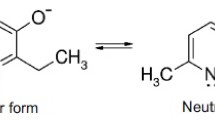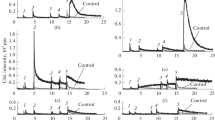en]Abstract
-
1.
In reduced and anaerobic suspensions of rabbit liver microsomes 2% of added CCl4 (1 mM) is converted to CHCl3 within 5 min. The CHCl3 formation is 50% inhibited by metyrapone, 75% by CO and 95% by O2.
-
2.
Oral application of 2.5 ml/kg CCl4 to rats produces a 30 to 40% loss of endoplasmic cytochrome P-450 within the first 3 h. This decline is not prevented by treatment of the rats with metyrapone, desipramine, piperonylbutoxide, disulfiram or silymarine.
-
3.
The decrease of cytochrome P-450 can be initiated in vitro by aerobic incubation of isolated liver microsomes with NADPH, and is accelerated further by CCl4. A good correlation was found between the rate of lipid peroxidation and the disappearance of cytochrome P-450. EDTA or GSH block lipid peroxidation and, consequently, the content of cytochrome P-450 remains at control levels even in the presence of CCl4. UV-irradiation of suspensions of microsomes effects lipid peroxidation and rapid destruction of cytochrome P-450.
-
4.
During the incubation of liver microsomes with linolenic acid and lipoxygenase from soybeans a similar correlation between cytochrome P-450 decline and lipid peroxidation was observed. Addition of either linolenic acid or lipoxygenase had no effects. Experiments and results indicate a coupled mechanism of lipidperoxidation with simultaneous oxidative breakdown of the haeme moities.
Zusammenfassung
-
1.
In reduzierten und anaeroben Suspensionen von Kaninchenlebermikrosomen werden 2% von zugegebenem CCl4 (1 mM) innerhalb von 5 min zu CHCl3 umgewandelt. Die Bildung von CHCl3 wird durch Metyrapon um 50%, durch CO um 75% und durch O2 um 95% gehemmt.
-
2.
Orale Gaben von 2,5 ml/kg CCl4 an Ratten bewirken innerhalb der ersten 3 Std einen Abfall des endoplasmatischen Cytochroms P-450 um 30 bis 40%. Diese Verringerung wird durch Behandlung der Ratten mit Metyrapon, Desipramin, Piperonylbutoxid, Disulfiram oder Silymarin nicht verhindert.
-
3.
Die Abnahme von Cytochrom P-450 kann in vitro durch aerobes Inkubieren von isolierten Lebermikrosomen mit NADPH in Gang gesetzt werden und wird durch CCl4 weiter beschleunigt. Zwischen dem Ausmaß der Lipidperoxidation und der Abnahme von Cytochrom P-450 wurde eine gute Korrelation gefunden. ÄDTA oder GSH verhindern die Lipidperoxidation. Infolgedessen ändert sich der Gehalt an Cytochrom P-450 sogar in Gegenwart von CCl4 gegenüber den Kontrollen nicht. UV-Bestrahlung von Mikrosomensuspensionen bewirkt Lipidperoxidation und schnelle Zerstörung von Cytochrom P-450.
-
4.
Während der Inkubation von Lebermikrosomen mit Linolensäure und Lipoxygenase aus Sojabohnen wurde eine ähnliche Beziehung zwischen der Abnahme von Cytochrom P-450 und der Lipidperoxidation beobachtet. Zugabe von Linolensäure oder Lipoxygenase allein hatte keine Wirkungen. Die Untersuchungen und Befunde sprechen für einen gekoppelten Mechanismus der Lipidperoxidation mit gleichzeitiger oxidativer Zerstörung des Häm-Anteils.
Similar content being viewed by others
Literatur
Arstila, A. U., Smith, M. A., Trump, B. F.: Microsomal lipid peroxidation: Morphological characterization. Science 175, 530–533 (1972).
Butler, T. C.: Reduction of carbon tetrachloride in vivo and reduction of carbon tetrachloride and chloroform in vitro by tissues and tissue constituents. J. Pharmacol. exp. Ther. 134, 311–319 (1961).
Castro, J. A., Sasame, H. A., Süssmann, H., Gillette, J. R.: Diverse effects of SKF 525-A and antioxidants on carbon tetrachloride-induced changes in liver microsomal P-450 content and ethylmorphine metabolism. Life Sci. 7, 129–136 (1968).
Cessi, C., Colombini, C., Mameli, L.: The reaction of liver proteins with a metabolite of carbon tetrachloride. Biochem. J. 101, 46c (1966).
Christopherson, B. O.: The inhibitory effects of reduced glutathione on the lipid peroxidation of the microsomal fraction and mitochondria. Biochem. J. 106, 515–522 (1968).
Cignoli, E. V., Castro, J. A.: Effects of inhibitors of drug metabolizing enzymes on carbon tetrachloride hepatotoxicity. Toxicol. appl. Pharmacol. 18, 625–637 (1971).
Dingell, J. V., Heimberg, M.: The effects of aliphatic halogenated hydrocarbons on hepatic drug metabolism. Biochem. Pharmacol. 17, 1269–1278 (1968).
Elger, J., Volkmann, H. J., Wahrenberg, I., Klinger, W.: Normaktivitäten von GOT, GPT und Histidase in Leberhomogenat und Serum sowie Veränderungen der Enzymaktivitäten nach Tetrachlorkohlenstoff-Applikation bei unterschiedlich alten Ratten. Arch. Toxikol. 27, 40–52 (1970).
Falk, J. E.: In: Porphyrines and metalloporphyrines, p. 181. Amsterdam: Elsevier 1964.
Fowler, J. S. L.: Carbon tetrachloride metabolism in the rabbit. Brit. J. Pharmacol. 37, 733–737 (1969).
Garner, R. C., McLean, A. E. M.: Increased susceptibility to carbon tetrachloride poisoning in the rat after pretreatment with oral phenobarbitone. Biochem. Pharmacol. 18, 645–650 (1969).
Gordis, E.: Lipid metabolites of carbon tetrachloride. J. clin. Invest. 48, 203–209 (1969).
Greene, F. E., Stripp, B., Gillette, J. R.: The effect of carbon tetrachloride on heme and ethylmorphine metabolism in rat liver microsomes. Biochem. Pharmacol. 18, 1531–1533 (1969).
Heni, N.: Abnahme des Cytochroms P-450 nach Inkubation mit CCl4 in einem NADPH-regenerierenden System und teilweise Umwandlung in Cytochrom P-420. Experientia (Basel) 27, 777–778 (1971).
— Remmer, H.: Die Wirkung von Tetrachlorkohlenstoff auf endoplasmatische Enzyme der Rattenleber. Arch. Toxikol. 28, 1–11 (1971).
Hove, E. L.: Interrelation between α-tocopherol and protein metabolism. III. The protective effect of vitamin E and certain nitrogenous compounds against CCl4 poisoning in rats. Arch. Biochem. 17, 467–474 (1948).
Hrycay, E. G., O'Brien, P.: Cytochrome P-450 as a microsomal peroxidase utilizing a lipid peroxide substrate. Arch. Biochem. 147, 14–27 (1971a).
— The peroxidase nature of cytochrome P-420 utilizing a lipid peroxide substrate. Arch. Biochem. 147, 28–35 (1971b).
Klaassen, C. D., Plaa, G. L.: Comparison of the biochemical alterations elicited in livers from rats treated with carbon tetrachloride, chloroform, 1,1,2-trichloroethane and 1,1,1-trichloroethane. Biochem. Pharmacol. 18, 2019–2027 (1969).
Klinger, W., Neugebauer, A., Splinter, F. K.: Veränderungen der Biotransformation von Phenazon, Aminophenazon and Kodein als Zeichen der Frühschädigung der Rattenleber nach Tetrachlorkohlenstoffapplikation. Arch. Toxikol. 23, 178–185 (1968).
McLean, A. E. M., McLean, E. K.: The effects of diet and 1,1,1-trichloro-2,2-bis(p-chlorophenyl)ethane (DDT) on microsomal hydroxylating enzymes and on sensitivity of rats to carbon tetrachloride poisoning. Biochem. J. 100, 564–571 (1966).
Marchand, C., McLean, S., Plaa, G. L.: The effect of SKF 525-A on the distribution of carbon tetrachloride in rats. J. Pharmacol. exp. Ther. 174, 232–238 (1970).
Neubert, D., Maibauer, D.: Vergleichende Untersuchungen der oxidativen Wirkungen von Mitochondrien und Mikrosomen bei experimenteller Leberschädigung. Naunyn-Schmiedebergs Arch. exp. Path. Pharmak. 235, 291–300 (1959).
O'Brien, P. J.: Intracellular mechanisms for the decomposition of a lipid peroxide. I. Decomposition of a lipid peroxide by metal ions, heme compounds, and nucleophiles. Canad. J. Biochem. 47, 485–492 (1969).
Omura, T., Sato, R.: The carbon monoxide-binding pigment of liver microsomes. J. biol. Chem. 239, 2370–2378 (1964).
Paul, B. B., Rubinstein, D.: Metabolism of carbon tetrachloride and chloroform by the rat. J. Pharmacol. exp. Ther. 141, 141–148 (1964).
Recknagel, R. O.: Carbon tetrachloride hepatotoxicity. Pharmacol. Rev. 19, 145–208 (1967).
— Ghoshal, A. K.: Lipoperoxidation as a vector in carbon tetrachloride hepatotoxicity. Lab. Invest. 15, 132–146 (1966).
— Lombardi, B.: Studies of biochemical changes in subcellular particels of rat liver and their relationship to a new hypothesis regarding the pathogenesis of carbon tetrachloride fat accumulation. J. biol. Chem. 236, 564–569 (1961).
Reiner, O., Uehleke, H.: The effect of CCl4 on lipid peroxidation and cytochrome P-450 in the endoplasmic reticulum. Naunyn-Schmiedebergs Arch. Pharmacol. 270 (Suppl.), R 111 (1971a).
— Bindung von Tetrachlorkohlenstoff an reduziertes mikrosomales Cytochrom P-450 und an Häm. Z. physiol. Chem. 352, 1048–1052 (1971b).
Reynolds, E. S.: Liver parenchymal cell injury. IV. Pattern of incorporation of carbon and chlorine from carbon tetrachloride into chemical constituents of liver in vivo. J. Pharmacol. exp. Ther. 155, 117–125 (1967).
Sasame, H. A., Castro, J. A., Gillette, J. R.: Studies on the destruction of liver microsomal cytochrome P-450 by carbon tetrachloride administration. Biochem. Pharmacol. 17, 1759–1768 (1968).
Schnitger, F., Uehleke, H.: Der Einfluß von Dimethylnitrosamin, Tetrachlorkohlenstoff, Buttergelb und Cyclophosphamid auf den Aminosäureneinbau in Fraktionen von Leberhomogenaten nach metabolischer Aktivierung in vitro. Arch. Toxikol. 25, 169–182 (1969).
Schotz, M. C., Recknagel, R. O.: Rapid increase of rat liver triglycerides following carbon tetrachloride poisoning. Biochim. biophys. Acta (Amst.) 41, 151–152 (1960).
Seawright, A. A., McLean, A. E. M.: The effect of diet on carbon tetrachloride metabolism. Biochem. J. 105, 1055–1060 (1967).
Slater, T. F.: The inhibitory effects in vitro of phenothiazines and other drugs on lipid-peroxidation systems in rat liver microsomes, and their relationship to the liver necrosis produced by carbon tetrachloride. Biochem. J. 106, 155–160 (1968).
— Sawyer, B. C.: The hepatotoxic action of carbon tetrachloride on lipid peroxidation in microsomal suspensions. FEBS Letters 11, 132–136 (1970).
Smuckler, E. A., Arrhenius, E., Hultin, E.: Alterations in microsomal electron transport, oxidative N-demethylation and azo-dye cleavage in carbon tetrachloride and dimethylnitrosamine-induced liver injury. Biochem. J. 103, 55–64 (1967).
Tappel, A. L.: Lipids and their oxidation, p. 122. Westport: Avi Publ. Co. Inc. 1962.
Tenhunen, R., Marver, H. S., Schmid, R.: Microsomal heme oxygenase. J. biol. Chem. 244, 6388–6394 (1969).
Uehleke, H.: Stoffwechsel von Arzneimitteln als Ursache von Wirkungen, Nebenwirkungen und Toxizität. Fortschr. Arzneimittel-Forsch. (Jucker, E., Ed.) 15, 147–203 (1971a).
— N-Hydroxylation. Xenobiotioa 1, 327–338 (1971b).
— Schnitger, F., Hellmer, K. H.: Verhalten verschiedener mikrosomaler Fremdstoff-Oxidationen nach Inaktivierung von Cytochrom P-450 durch UV-Bestrahlung oder durch Desoxycholatbehandlung. Z. physiol. Chem. 351, 1475–1484 (1970).
Wills, E. D.: Lipid peroxide formation in microsomes. The role of non-haem iron. Biochem. J. 113, 325–332 (1969).
Author information
Authors and Affiliations
Additional information
Die Ergebnisse wurden teilweise auf der 12. Frühjahrstagung der Deutschen Pharmakologischen Gesellschaft vom 21. bis 24. März 1971 in Mainz vorgetragen (Rainer u. Uehleke, 1971a).
Diese Untersuchungen wurden durch eine Sachbeihilfe der Deutschen Forschungsgemeinschaft unterstützt.
Rights and permissions
About this article
Cite this article
Reiner, O., Athanassopoulos, S., Hellmer, K.H. et al. Bildung von Chloroform aus Tetrachlorkohlenstoff in Lebermikrosomen, Lipidperoxidation und Zerstörung von Cytochrom P-450. Arch Toxicol 29, 219–233 (1972). https://doi.org/10.1007/BF00315600
Received:
Issue Date:
DOI: https://doi.org/10.1007/BF00315600




